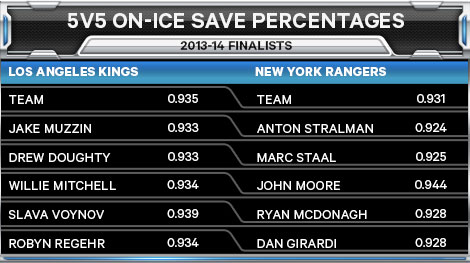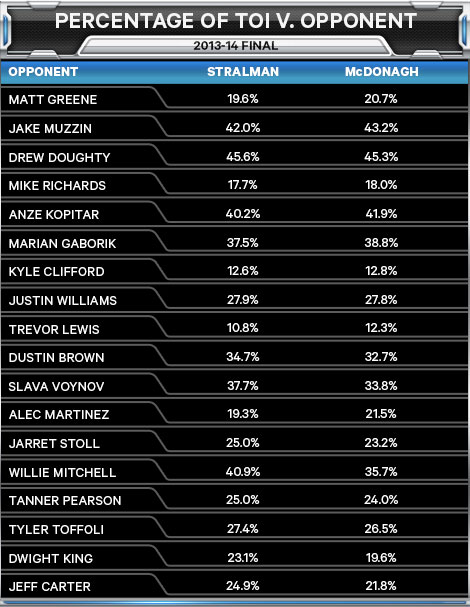I have long harboured a suspicion that when it comes to evaluating defencemen, it takes the media (and, in many cases, those inside the game) quite some time to figure out if a guy is any good. A lot of this has to do with the nature of the position. Defencemen generally don’t score a lot of points, which makes it hard to evaluate them that way. And, like everyone else on the ice, blueliners are subject to randomness in terms of shooting and save percentage, which makes plus-minus an unreliable indicator.
Historically, we haven’t really had a lot of good, reliable statistical indicators for defencemen. As we get to understand more about how the game works from a numbers perspective, better indicators are being developed. The most important indicator for 5-on-5 play, in terms of top four D-men, is looking at how a player’s team does in terms of Corsi% with him on the ice and with him on the bench.
The logic behind this is pretty simple. Many studies have tried to find some sort of an impact that blueliners make on their teams’ save percentages, with no luck. The save percentage that a team’s defencemen put up tend to be tightly clustered around that posted by a team’s goalie. When a defenceman has a season in which his save percentage is much better or much worse than the team average, he doesn’t tend to repeat it the following year. This implies that D-men don’t have a significant impact on the stat.
You can see this if we look at the defencemen who played at least 62 games for this year’s Stanley Cup finalists.

Except for John Moore in New York, all of them are within a few points of their team’s save percentage. Third-pairing defencemen post higher on-ice save percentages than top-four blueliners more often, presumably because fewer of the shots taken when they’re on the ice are from high-end forwards.
The key point here, though, is that what makes defencemen great at 5v5 isn’t really an ability to help their goalie stop more shots. It’s also not an ability to help their team post a significantly higher shooting percentage. This is presumably less controversial because defencemen are rarely taking shots from dangerous spots or making passes that lead to tap-ins.
If you take those two factors out, all that’s left is a D-man’s ability to increase his team’s shot-attempt volume and decrease the opposition’s. This is measured by looking at Corsi%. The work that’s been done to date suggests that this is the most important skill to look for in a defenceman. Of course, this can take many different forms. He might be good at quickly breaking the puck out of his own end. He might be great at forcing the opposition to dump the puck in as opposed to carrying it in. He could be really good at preventing the opposition from cycling, forcing turnovers. That’s just style though—what matters are the results.
In the discussion of the Rangers leading into this series, there was a lot of talk about three defencemen: Ryan McDonagh, Dan Girardi and Marc Staal. McDonagh is a U.S. Olympian, recognized as one of the best defenders in the NHL. Girardi has received first-place nods in Norris Trophy voting in the past. Staal’s from hockey’s current First Family.
One guy flew under the radar: Anton Stralman, who generally plays on the right side with Marc Staal. Despite this, if you look at how the Rangers’ top-four defencemen have done in terms of Corsi% in the Cup final, Stralman comes out very well.

In fact, New York’s second pairing has done significantly better than the putative first pairing. You might be inclined to guess that McDonagh-Girardi see more of the Kings’ best players than Stralman-Staal, but that hasn’t been the case.

Staal and Stralman certainly don’t have the pedigree of Girardi and McDonagh. Despite that, they’ve posted better results in the final. If you look at the forwards with whom they’ve played, it’s pretty similar.
Even more curious, this happened in the regular season as well. The Rangers did better at 5v5 with Stralman on the ice than they did with any other defenceman. And their best pairing was Stralman-McDonagh, not McDonagh-Girardi. Staal did worse with Girardi than he did with Stralman, which leads to a reasonable inference that Stralman is pretty valuable: he seems to have a big impact on his team’s Corsi% when he’s on the ice.
It will be interesting to see how Stralman’s career progresses from this point. He seems to have come into his own over the past year and a half in New York, although it’s gone under the radar. He’s enjoyed a very good final, in keeping with his season but continues to be basically unnoticed. It will be fascinating to see where he ends up this summer and the impact he has next season. If he continues to have a similar impact on games, he won’t go unmentioned the next time he’s on a team that goes deep in the playoffs.

